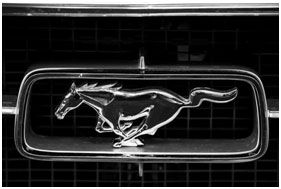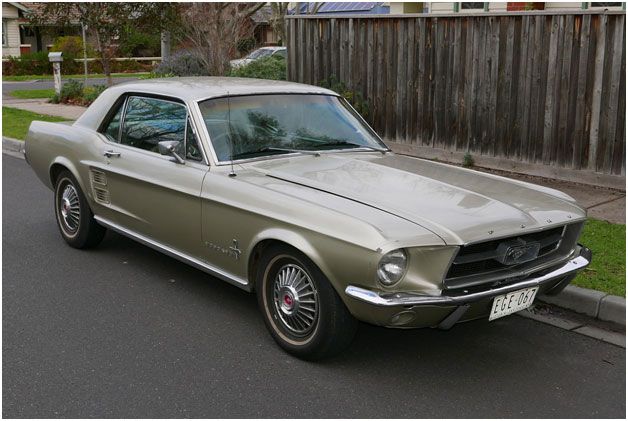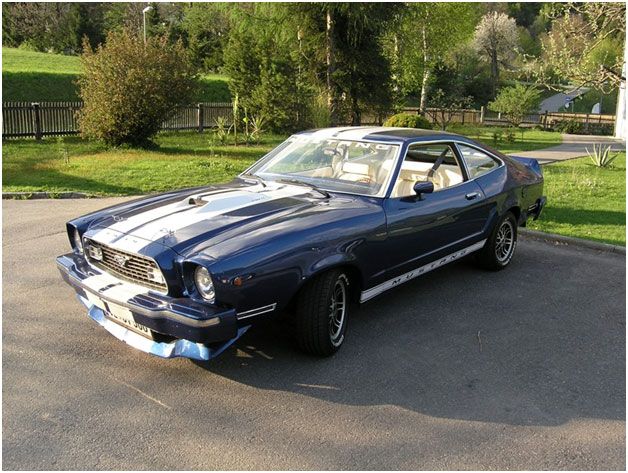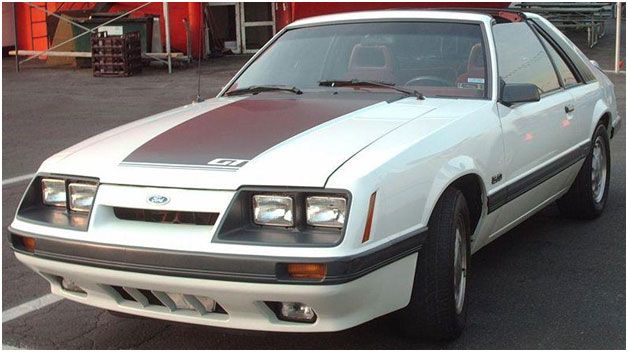
Ford Mustang Models and History
Written By John Linden
No other automobile combines mankind’s lust for power with engineering and design quite like the Ford Mustang. Surviving longer than most other models in its class, few sports cars are as iconic. For many Americans, the very idea of the American Dream can be summed up with the sound of a revving 1965 Ford Mustang. And as the American Dream changed, so did the Ford Mustang. Embracing consumers desires for a high-performance automobile that didn't chug gasoline, didn't take up a large amount of space, and wouldn't require continuous self-maintenance, Ford and its Mustang have carved out an untouchable place in the automotive industry, and rule supreme as the King of Sports Cars.
The Thirst for High Performance

With roots in the illegal modification of mass-produced vehicles by bootleggers and moonshiners to outrun law enforcement during the first half of the 20th Century, hot rodding and modifying mass-produced automobiles became a popular pastime. By the 1950s, drivers and engineers saw what was possible with some modifications to body design and engine power. There was no going back. Since the release of the Oldsmobile Rocket 88 in 1949, arguably the first mass-produced high performance consumer automobile, companies like Ford, Chevy, and Dodge have clamored to outdo each other with the fastest and sleekest sports car they can muster.
With the evolution of automobile engines in the next decade, especially the creation of the small block engine, mechanical fuel injection, and Hemi series of V8 engines. As the nascent "pony" and "muscle" cars were largely imperfect, they experienced extreme variations in handling and performance.
Just as it was taking off, the automobile industry faced resistance from within and around with the high profile accidents that were the result of drag racing high performance automobiles. In the 1955 24 Hours of Le Mans Race, a driver crashed into the spectator viewing area and 84 people were killed.
Fortunately for enthusiasts, the ban was ultimately lifted and the automotive industry again refocused on improving performance while streamlining there designs in a way that allowed the vehicles to perform better than had ever been seen.
Manufacturers like Pontiac, Chevy, and Ford responded to the need for reliable high performance vehicles with the creation of several sports cars that would combine street legal restrictions with modifiable performance packages and equipment so that racing enthusiasts would be happy. These so called “pony cars” would offer highly stylized coupe designs with extra-long hoods and shorter decks than traditional consumer models.
The Creation of an Icon

With the popularity of the four-seat sedan, the compact car had been losing popularity for years leading up to the creation of the Mustang. Led by the visionary energy of Lee Iacocca, the quest for a new sports car was commenced in 1962. Designers like Eugene Bordinat and Phillip T. Clark had presented low-riding and affordable sports car designs for years, and ultimately led the first design sessions for the Mustang. Roy Lunn led the actual building of the first Mustang prototype, and helped to flesh out the original design. The original design was retooled once more for the original Mustang II, still in prototype mode. While influenced largely by a committee of designers and engineers, the look of the first generation of Mustangs was ultimately created by David Ash.
The Mustang Name
John Najjar was a part of the committee that co-designed the original prototype of the Ford Mustang that would be dubbed the Ford Mustang is credited by some with suggesting the Mustang name. His liking for the P-51 Mustang fighter plane is said by many to have inspired his suggestion of the name. There is a debate as to whether it is actually a Ford Division market research manager by the name of Robert J. Eggert who deserves credit. He ultimately added the "Mustang" name to the list that was given to focus ground while they tested the viability of a name.
The Original Mustang

Photo By Alvintrusty
Combining elements of the Ford Falcon with the final Mustang redesign, the car was finally ready for sale. The first Ford Mustang was released to the public in late 1964 under the 1965 model year. With several upgrades available allowing consumers to upgrade the engine size and other frills, the Mustang was a hit and established itself as a serious contender to the Chevy Corvette and Pontiac GTO. Because it reused the Ford Falcon and Ford Fairlane's chassis, interior, and suspension, as well as drivetrain, it was able to be kept at a relatively affordable price, further enabling sales.
With an upgradable V6 and V8 engine and a hatchback or hardtop rear styling, the Ford Mustang immediately combined power and style and shook up the entire automotive industry.
The Late 1960s

Photo by OSX
The 1967 year saw a redesign of the original Mustang. The body was increased in size to allow for a larger V8 engine4 in most models. Differences to the interior styling and options inside further changed the feel of the Mustang. By 1969, there was even more body in the most literal sense. The wheel base was extended and body lengthened to make the Mustang appear even larger.
The Mustang GT was an original performance option offered in 1968 that was limited to the west coast and boasted even more unique features. It was featured in the high-profile movie Bullit.
Ford further offered the Mach 1 and Boss 203 models in 1969 to add further options for consumers. These offered high-performance stylistic changes like racing striping, dual exhausts, "shaker" hood scoop, and spoilers.
Bigger and Badder

Photo By Christian Pirker
With the increase in body size throughout the early 1970s, the Ford Mustang also began to fit larger and larger engines. The big block Cobra Jet engine was one of the most popular, and allowed the Mustang to remain popular at the drag strip.
The design of the Ford Mustang gradually became less aggressive after 1969, with a reduction in headlights and simplification of certain styling elements brought into play to increase sales. Air scoops and tail light panes were removed and flattened. The new Sportsroof option increased the length of the fastback roof and was heavily marketed.
With a change in emission regulations, the big block 429 engines were eliminated from production, even though the 1971 and 1972 models were still much larger than any Mustang before it.
By this time, Ford had lost interest in supporting the Mustang as a muscle care amidst declining sales. Consumers had begun to feel pressure at the gas pump and most muscle cars were losing popularity as they required a large amount of gas. The recent redesigns of the Mustang were proving unfavorable with consumers, leaving the fate of the Mustang uncertain.
A New Generation of Foreign Competitors
The 1973 and 1979 gas crisis put immense pressure on automotive makers to design and mass produce models that were not only stylistically interesting, but also affordable to drive. Consumers had made it clear that they weren't going to purchase models that put even more strain on their wallets than they could afford before. Japanese automakers had also entered the market and left a very strong impression. Their compact designs and smaller, fuel efficient engines left American automakers reeling. They had been championing bigger and heavier designs for years, but now were being beaten on their home turf by the complete opposite of their once successful designs.
The Ford Mustang, like most other American automobiles followed in the footsteps of their new Japanese competition. The Third Generation of Mustangs would be built on the larger Fox Platform to give passengers even more interior space, further increasing its appeal to families.
1982 saw the reintroduction of the Mustang GT which had been dormant for over a decade. It was designed with high power in mind, offering a 157 horsepower 5.0 Liter engine that gave it an upper hand against the other Mustang models. A smaller hood scoop and a front air dam with fog lampsfurther defined the new Mustang GT.
A new rounded nose and V-shaped grille with deep headlamps on the front end of the 1983 Ford Mustang greeted excited consumers. This body redesign would remain the standard for years until 1993.
After 1987 Mustangs were manufactured for the first time ever overseas in Venezuela. This would last only until 1993, but proved to be a turning point in the Mustang's history, as Mustangs would now be shipped as "imports" to America during this period.
The Fox 4 Platform and Fourth Generation

Photo byBull-Doser
After fourteen years, the Mustang was redesigned to meet the changing demands auto enthusiasts and consumers in the 1990s. Its new body style blended elements of the classic Mustangs built in the 1960s with modern production elements and materials to offer consumers still a lighter, more powerful vehicle. A stylish dual-cockpit in the cabin offered an increase in the luxury of the new Mustang, along with improved noise reduction and handling.
1999 saw the restyling of the fourth generation Mustang. Embracing Ford's "New Edge" design style, the new Mustang body had a much sharper looking front end and higher wheel wells. The base engine of this model was even more powerful than the years before, further increasing appeal. A newer split-port induction style system replaced the old single port induction which brought the new Mustang close to 200 horse power. This sort of performance brought the Mustang back to the racing crowd, and saw the Mustang return to the spotlight as a sports car to be reckoned with.
The D2C Platform and Nostalgia for the 60s

Photo By CarlaliasPacha
The 5th generation of Mustangs debuted in 2003. Offering a facelift designed by Sid Ramnarace that combined Ford's "New Edge" styling with a love of the wide grille style Mustangs in the late 1960s and early 1970s. It offered a number of variants including the GT, Boss, Shelby, and Bullit. The Bullit model is inspired by the Highland Green GT-390 fastback Mustang in the classic film Bullit, from 1968. With a cold air intake and unique exhaust system, the Bullit was built to sound similar to the classic model too.
2010 offered up a redesign of the D2C platform Mustangs with improved aerodynamic design in the exterior body. A new headlight design and a "powerdome" hood further increased the unique appeal of the new Mustang without changing its overalldimensions.
In 2013 a new front styling for the Ford Mustang was unveiled. The larger grill and a more rounded hood gave the Mustang a still more modern look.
The 6th Generation of Mustangs

Photo By Tobias "ToMar" Maier
For the most recent generation of Mustangs, Ford finally embraced and made standard fully independent rear suspension for all models. This was also the first model to be marketed globally as one homogenously branded unit. The "One Ford" plan being applied to the current Mustang is being applied accords all its models to streamline its approach around the world. This is a radical departure from Ford and most other's previous inclinations to release a different model in different countries.
A Sports Car Like No Other
To say there is no other sports car in the history of automobiles when discussing the Ford Mustang is an understatement. It single handedly returned the compact car to the spot light. Sports cars became a household name with the ascent of the Mustang, increasing visibility and sales.
Automakers were equally inspired by the Mustang. Ford's ability to offer a lower cost vehicle with high-performance components allowed it to outsell most of its competitors into its second generation.
As the price of gasoline increased and demand for smaller, more fuel efficient vehicles increased, the Ford Mustang followed suit with a new compact design and smaller engines. While other sports cars met their demise in the 1980s, the Mustang thrived for consumers and racing enthusiasts alike. The Mustang's ability to keep up with other modern American racing cars like the Buick Regal and Chevy Camaro has relied on its brand-name appeal and its affordable high-performance packages.
With the most recent generations of Mustang's, Ford has offered consumers of all levels even more power and luxury. With engines capable of nearly over 500 horse power, the Ford Mustang represents the very best in automotive engineering. Its popularity has shown no sign of waning, as year after year it ranks among the best selling automobiles in America. It continues to win races in all styles of drag and track racing. Without question, the Ford Mustang is one of the greatest achievements in automobile history. Not just on an individual model basis, but also as a brand. Its influenced has been felt on all levels of its existence, remaining memorable to consumers and game changing for automakers. It is also important that these car owners choose a mustang car covers to protect against scratches, dust, environmental damage, UV rays, and other hazards that can cause premature wear.
Featured Image Credit: Antranias / Pixabay
In Post image 1 Credit: LloydTheVoid / Pixabay
In Post Image 2 Credit: FrankWinkler / Pixabay
Updated